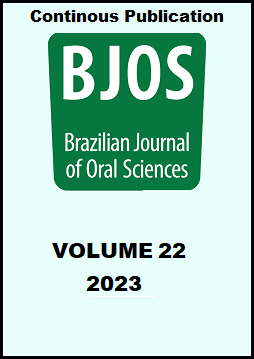Abstract
There is no consensus on the most appropriate method for normalizing electromyography (EMG) signals from masticatory muscles during isotonic activity. Aim: To analyze the best method for data processing of the EMG signal of the masticatory muscles during isotonic activity (non-habitual chewing), comparing raw data and different types of normalization. Methods: This is a cross-sectional study. Women aged between 18 and 45 years were selected. Anthropometric data were collected (age, height, body mass index – BMI, masticatory preference) as well as EMG signal (root mean square – RMS) data for the anterior temporal and masseter bilaterally, and for the suprahyoid muscles, during isotonic (non-habitual chewing) and isometric tasks. EMG data were processed offline using Matlab® Software. The normalization of the EMG signal was carried out using the 2nd masticatory cycle, chosen at random, of the 20 cycles collected, the maximum RMS value, and the maximum voluntary contraction (MVC). To analyze the best method of data processing for the isotonic data, the coefficient of variation (CV) was calculated. Descriptive data analysis was adopted, using the mean and standard deviation. ANOVA with repeated measures was used to detect significant differences between the methods of normalization. Statistical significance was set at 5% (α<0.05). Results: The final sample of this research was composed of 86 women. The volunteers presented an average age of 27.83±7.71 years and a mean BMI of 22.85±1.91 Kg/m2. Regarding masticatory preference, 73.25% reported the right side, and 26.75% the left side. Considering the comparison between the methods, the %CV measure of the 2nd cycle showed the lowest variation coefficient during biting for all the muscles from the raw data, RMS Max, and MVC (p=0.001, p=0.003, and p=0.001 respectively). Conclusion: In conclusion, for non-habitual chewing activity, the results of this study recommend data processing using normalization with the second cycle during chewing.
References
Duarte-Kroll C, Bérzin F, Alves MC. [Clinical evaluation of masticatory muscle activity during habitual mastication - a study on the normalization of electromyographic data]. Rev Odontol UNESP. 2010;39(3):157-62. Portuguese.
Cabral EEA, Fregonezi GAF, Melo L, Basoudan N, Mathur S, Reid WD. Surface electromyography (sEMG) of extradiaphragm respiratory muscles in healthy subjects: a systematic review. J Electromyogr Kinesiol. 2018 Oct;42:123-35. doi: 10.1016/j.jelekin.2018.07.004.
Schwartz C, Tubez F, Wang FC, Croisier JL, Brüls O, Denoël V, Forthomme B. Normalizing shoulder EMG: An optimal set of maximum isometric voluntary contraction tests considering reproducibility. J Electromyogr Kinesiol. 2017 Dec;37:1-8. doi: 10.1016/j.jelekin.2017.08.005.
Soderberg GL, Knutson LM. A guide for use and interpretation of kinesiologic electromyographic data. Phys Ther. 2000 May;80(5):485-98.
Burden A. How should we normalize electromyograms obtained from healthy participants? What we have learned from over 25 years of research. J Electromyogr Kinesiol. 2010 Dec;20(6):1023-35. doi: 10.1016/j.jelekin.2010.07.004.
Lehman GJ, McGill SM. The importance of normalization in the interpretation of surface electromyography: a proof of principle. J Manipulative Physiol Ther. 1999 Sep;22(7):444-6. doi: 10.1016/s0161-4754(99)70032-1.
Tabard-Fougère A, Rose-Dulcina K, Pittet V, Dayer R, Vuillerme N, Armand S. EMG normalization method based on grade 3 of manual muscle testing: Within- and between-day reliability of normalization tasks and application to gait analysis. Gait Posture. 2018 Feb;60:6-12. doi: 10.1016/j.gaitpost.2017.10.026.
Pelai EB, Foltran-Mescollotto F, de Castro-Carletti EM, de Moraes M, Rodrigues-Bigaton D. Comparison of the pattern of activation of the masticatory muscles among individuals with and without TMD: A systematic review. Cranio. 2023 Mar;41(2):102-111. doi: 10.1080/08869634.2020.1831836.
Jones T, Shinohara M. A submaximal normalization of EMG signals in trunk muscle groups. 2022 May [2022 Aug 15. Available from: https://repository.gatech.edu/server/api/core/bitstreams/eec034f5-0b4f-4a74-9588-2d82d4cac7a0/content.
Cram JR. Electrode Placement. In: Cram’s introduction to surface electromyography. Boston: Jones & Bartlett Publishers; 2005. Chapter 14, p.237-389.
Berni KC, Dibai-Filho AV, Rodrigues-Bigaton D. Accuracy of the Fonseca anamnestic index in the identification of myogenous temporomandibular disorder in female community cases. J Bodyw Mov Ther. 2015 Jul;19(3):404-9. doi: 10.1016/j.jbmt.2014.08.001.
Pitta NC, Nitsch GS, Machado MB, de Oliveira AS. Activation time analysis and electromyographic fatigue in patients with temporomandibular disorders during clenching. J Electromyogr Kinesiol. 2015 Aug;25(4):653-7. doi: 10.1016/j.jelekin.2015.04.010.
Brown CE. Coefficient of variation. In: Brown CE. Applied multivariate statistics in geohydrology and related sciences. Springer; 1998. p. 155-7. doi: 10.1007/978-3-642-80328-4_13.
Reed P, Romano M, Re F, Roaro A, Osborne LA, Viganò C, rt al. Differential physiological changes following internet exposure in higher and lower problematic internet users. PLoS One. 2017 May;12(5):e0178480. doi: 10.1371/journal.pone.0178480.
Albertus-Kajee Y, Tucker R, Derman W, Lamberts RP, Lambert MI. Alternative methods of normalising EMG during running. J Electromyogr Kinesiol. 2011 Aug;21(4):579-86. doi: 10.1016/j.jelekin.2011.03.009.
Chuang TD, Acker SM. Comparing functional dynamic normalization methods to maximal voluntary isometric contractions for lower limb EMG from walking, cycling and running. J Electromyogr Kinesiol. 2019 Feb;44:86-93. doi: 10.1016/j.jelekin.2018.11.014.
Fernández-Peña E, Lucertini F, Ditroilo M. A maximal isokinetic pedalling exercise for EMG normalization in cycling. J Electromyogr Kinesiol. 2009 Jun;19(3):e162-70. doi: 10.1016/j.jelekin.2007.11.013.
Fraga CHW, Candotti CT. [Estudo comparativo sobre diferentes métodos de normalização do sinal eletromiográfico aplicados ao ciclismo]. Rev Bras Biomec. 2008;9:124-9. Portuguese.

This work is licensed under a Creative Commons Attribution 4.0 International License.
Copyright (c) 2022 Elisa Bizetti Pelai, Ester Moreira de Catro-Carletti, Fabiana Foltran-Mescollotto, Paulo Fernandes Pires, Fausto Berzin, Marcio de Moraes, Delaine Rodrigues-Bigaton


